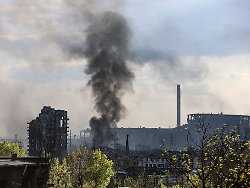Fighting feared in steel mill
Hope for soldiers in Mariupol is fading
05/08/2022 11:57 am
An evacuation of the Ukrainian fighters entrenched in the Azovsteel plant in Mariupol hardly seems achievable. After all civilians are rescued, Ukrainians report Russian shelling. Losing fights in the tunneled industrial complex are becoming more and more likely.
After all civilians were evacuated from the Azov steelworks in Mariupol, Ukraine fears merciless fighting between its soldiers who are holed up there and Russian troops. The Ukrainian general staff announced in the morning that the units in the steelworks area were still blocked. There are “Russian attacks” with “support from artillery and tank attacks”.
“The enemy is trying to finish off the defenders of Azov Steel, they are trying to do it before May 9 as a gift to (Russian President) Vladimir Putin,” Oleksiy Arestovych, adviser to Ukrainian President Volodymyr Zelenskyy, said on Tuesday Friday. Russia celebrates the Soviet Union’s victory over Nazi Germany on May 9 with a traditional military parade.
Hundreds of soldiers have holed up in the industrial complex, which is the last bastion of the Ukrainian military in the devastated port city of Mariupol. Should the steelworks eventually fall, the Russians would have taken the strategically important port city entirely, which would be an important military success for Moscow.
Moscow’s declared goal is to establish a land connection between the Black Sea peninsula of Crimea, annexed in 2014, and the eastern Ukrainian regions of Luhansk and Donetsk controlled by pro-Russian separatists. Since February 24, Russian troops have taken control of only one major Ukrainian city, Kherson.
Selenskyj spoke on Saturday evening of 300 people who had been taken out of the steel mill. It is a “second phase” of evacuations in preparation for “the injured and medical personnel”. The government is “of course also working to get our soldiers out. All these heroes defending Mariupol,” Zelenskyy added, without giving any figures. “It’s extremely difficult. But it’s important.”
“Many soldiers are in bad condition. They are wounded and have no medicine,” said military nurse Yevgenya Tytarenko, whose husband, a nurse and member of the Azov regiment, is still at the steel mill. “There is also a lack of food and water.”
“I will fight to the end,” Yevgenia’s husband Mykhailo said in a text message she showed to AFP reporters. The two had married two days before the Russian invasion.
“How can I return when the city is no more?”
Deputy Prime Minister Iryna Vereshchuk announced on Saturday evening that all remaining civilians – “women, children and the elderly” – had been taken out of the steelworks. Residents of the port city in south-eastern Ukraine, which had been under siege for weeks, had sought refuge in the tunnels and bunkers of the steelworks.
According to Ukrainian information, in the course of UN-led operations, over the past few days more than 500 civilians have been evacuated from the city and from the steel works. Some of them described being strip-searched by Russians, fingerprinted and cellphones checked.
“They asked us whether we wanted to go to Russia or stay in the self-proclaimed Donetsk People’s Republic,” said Natalia, who did not want her full name published. The Russians also offered them “to stay and rebuild the city of Mariupol,” she said. “But how can I rebuild it? How can I go back there if the city of Mariupol is no more?”
